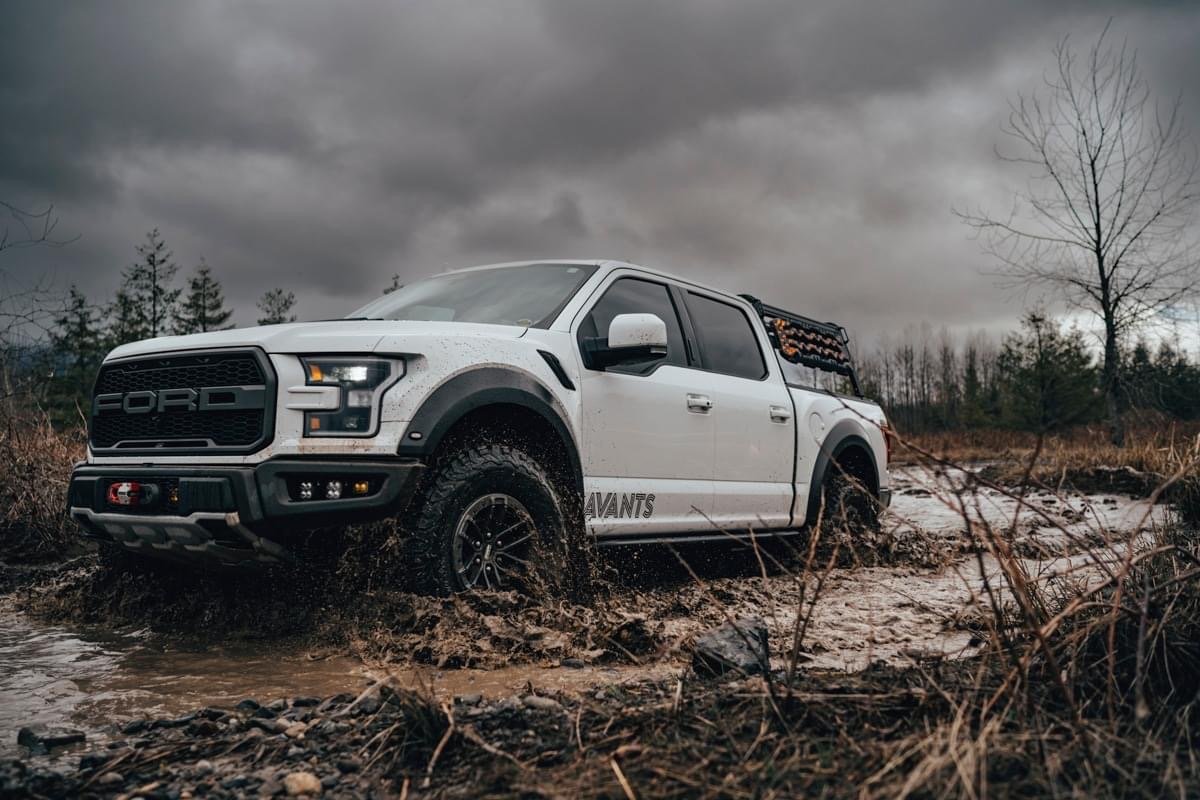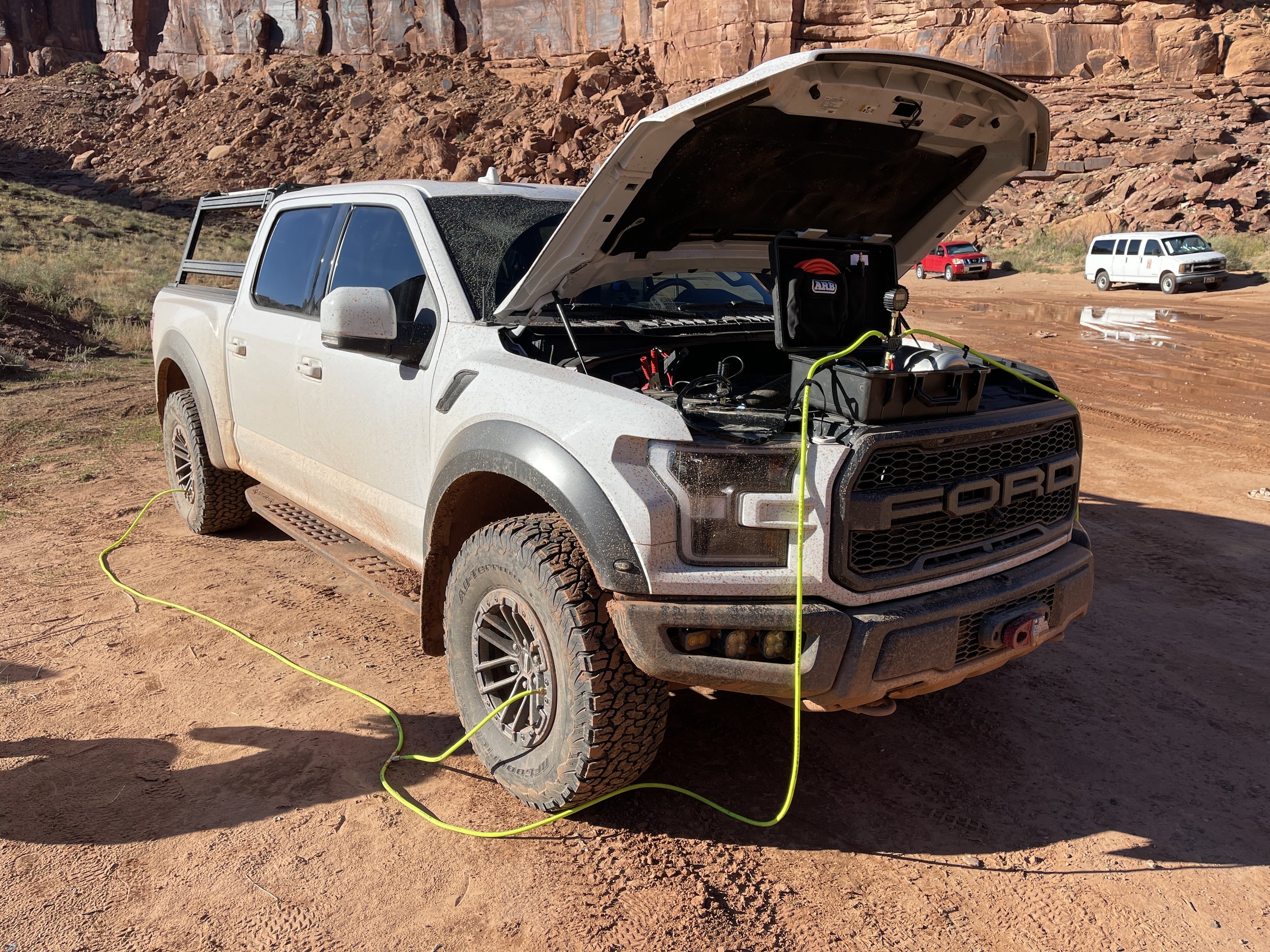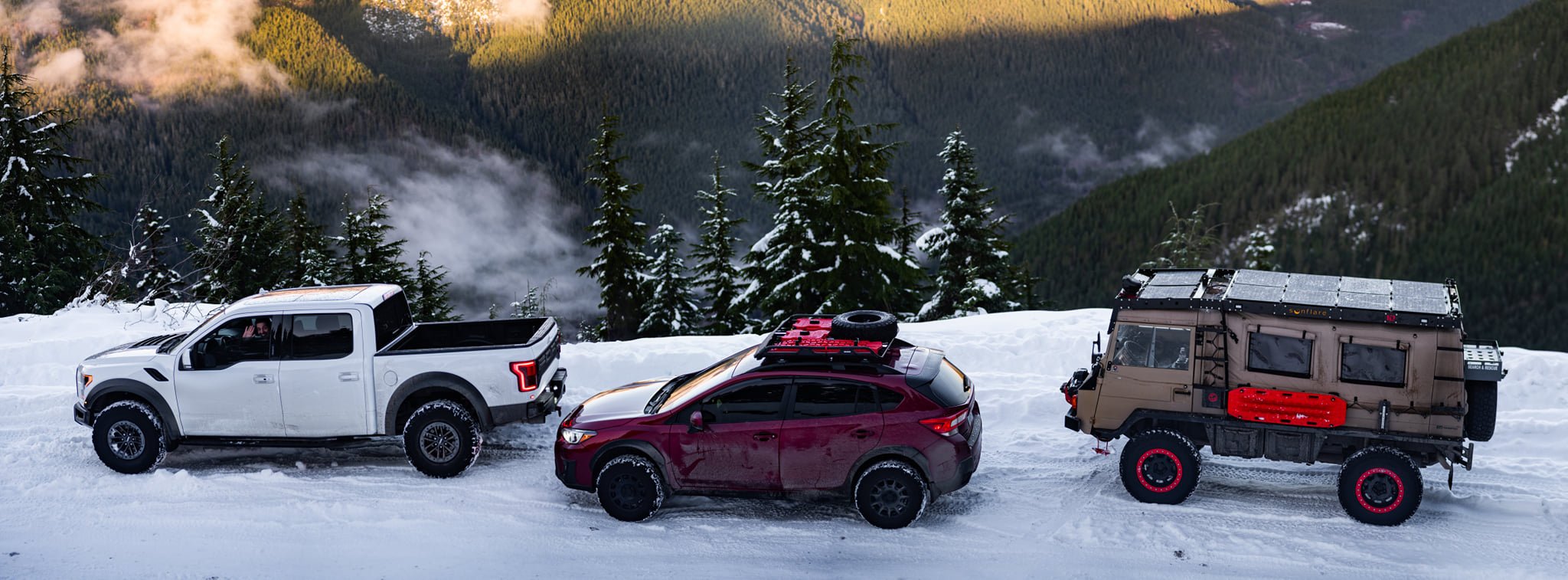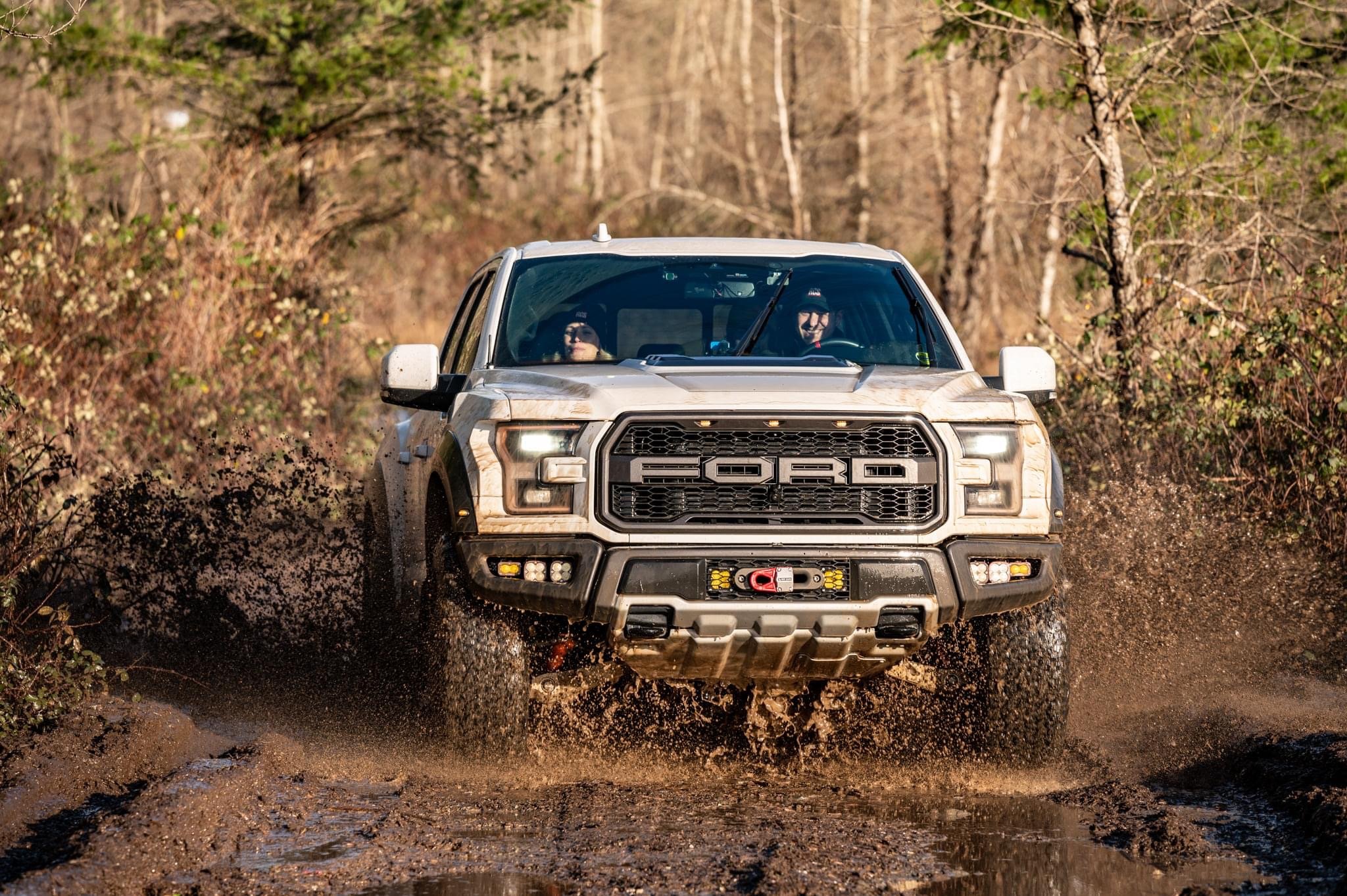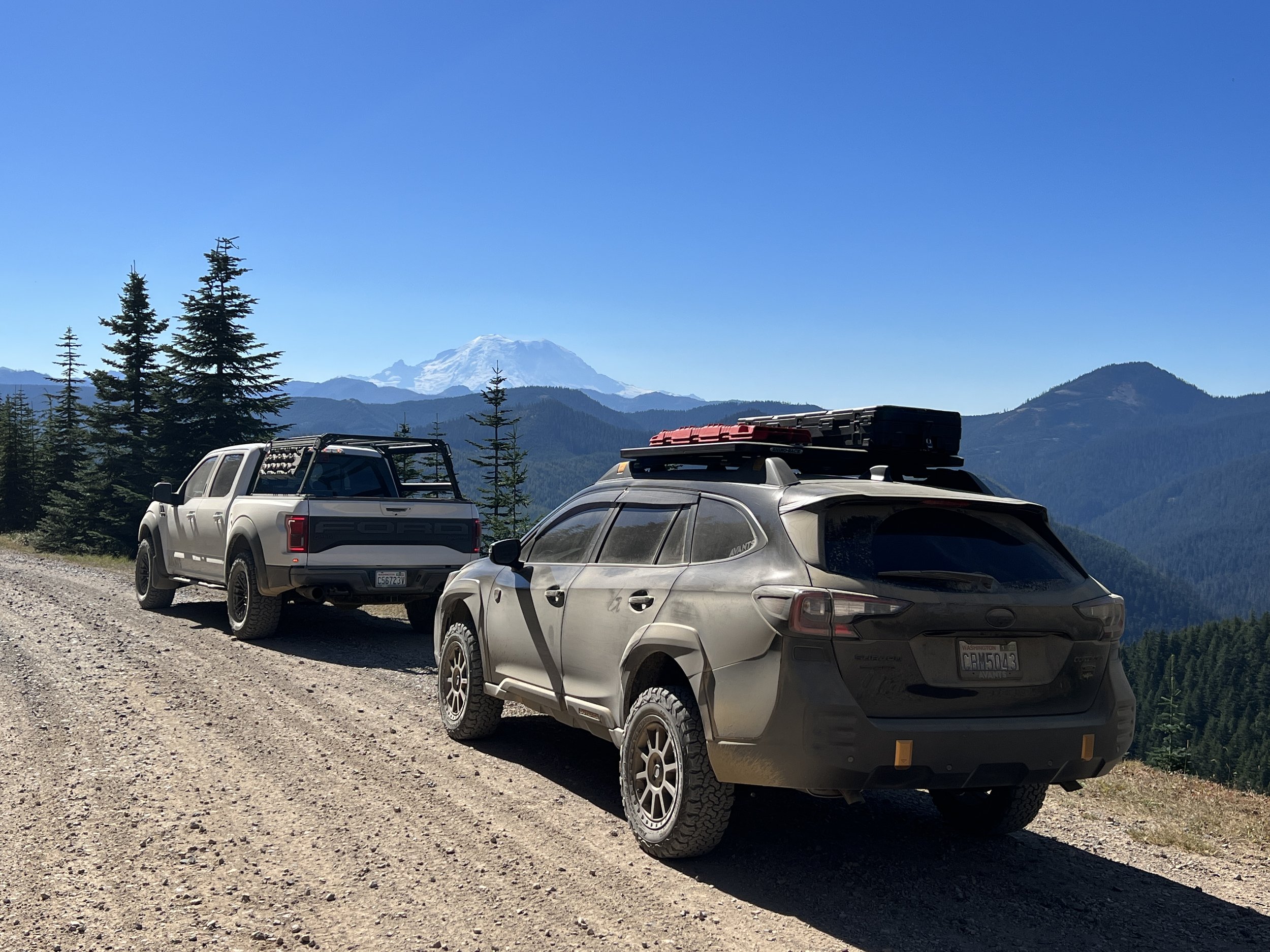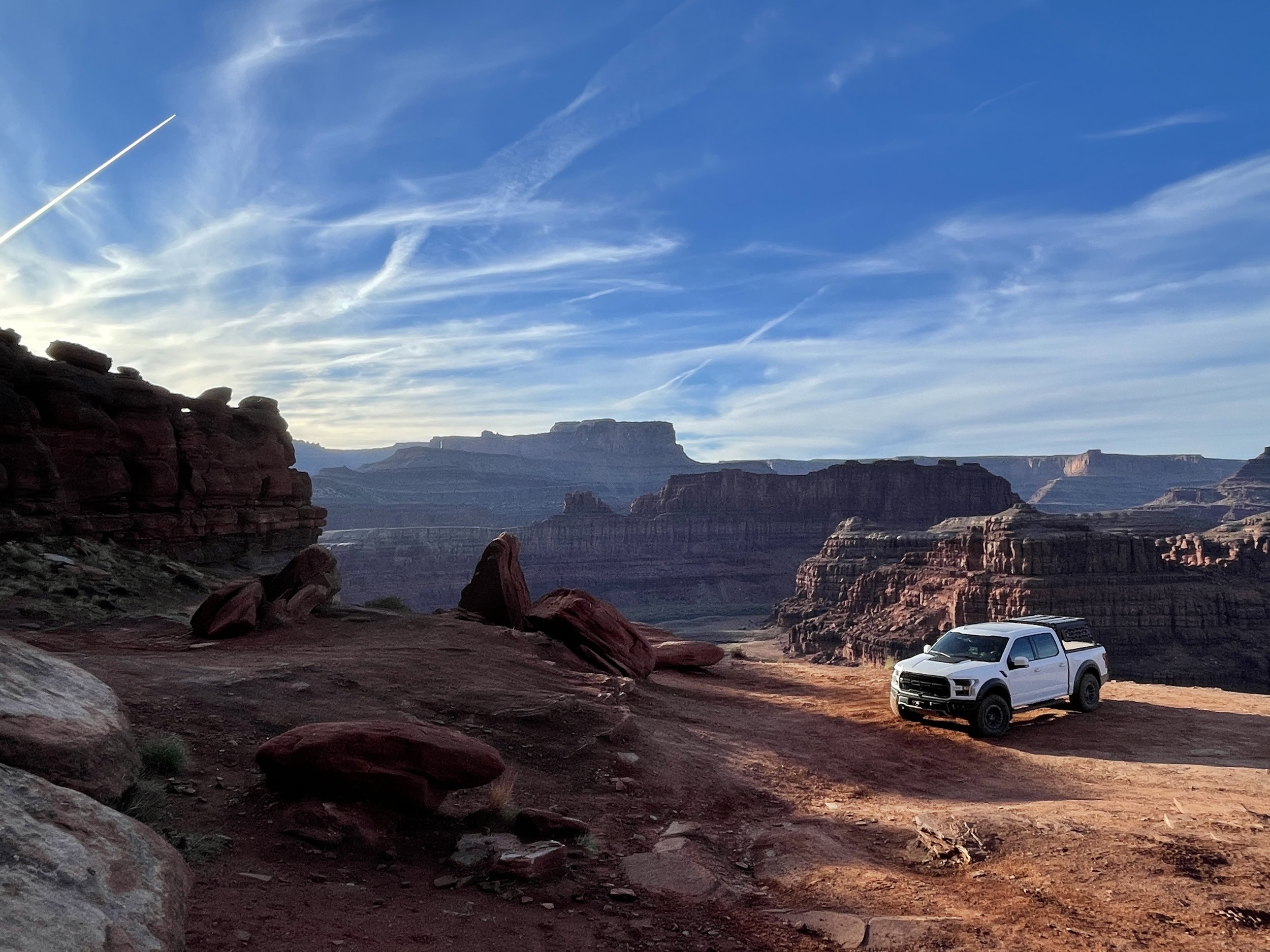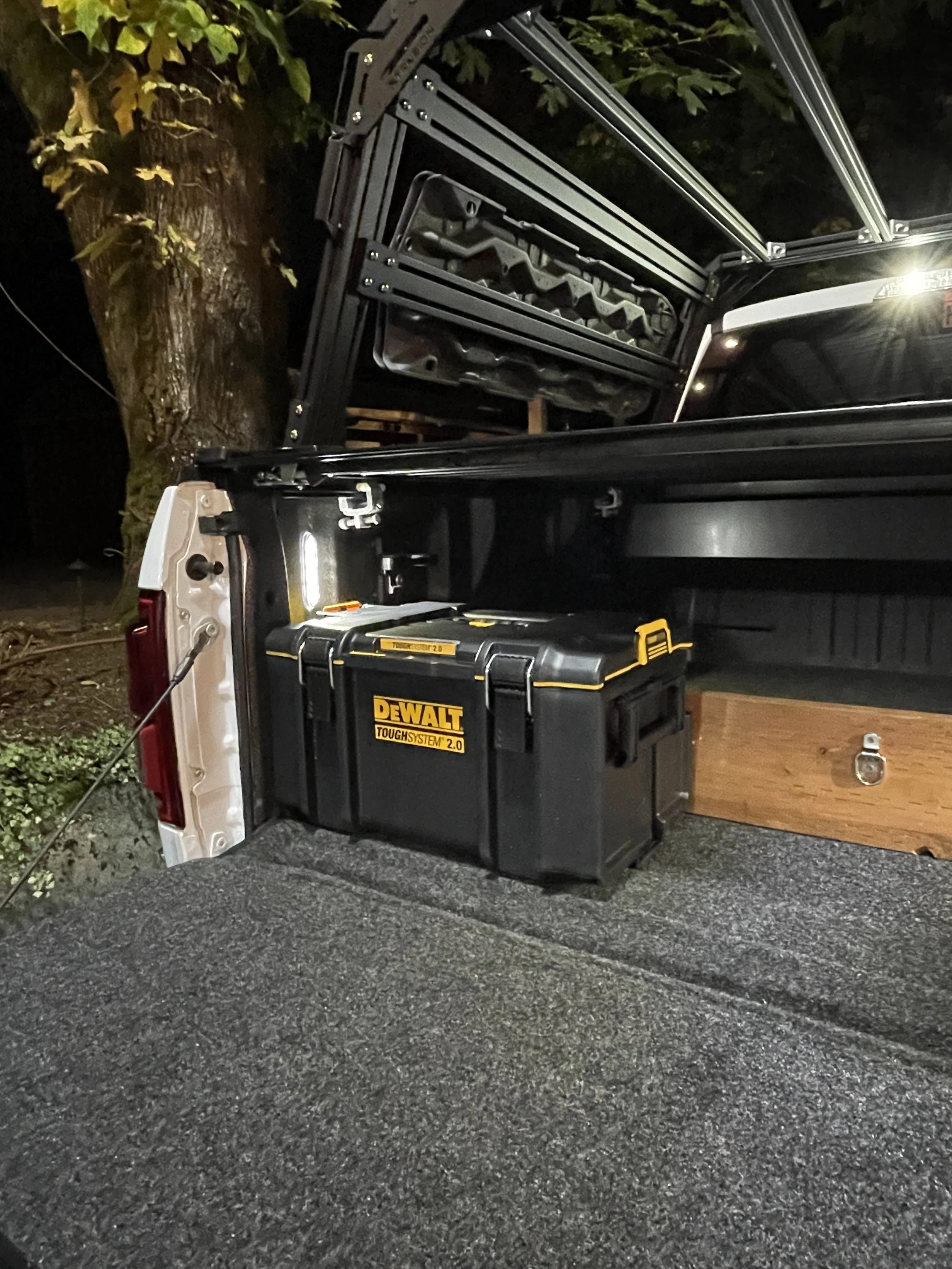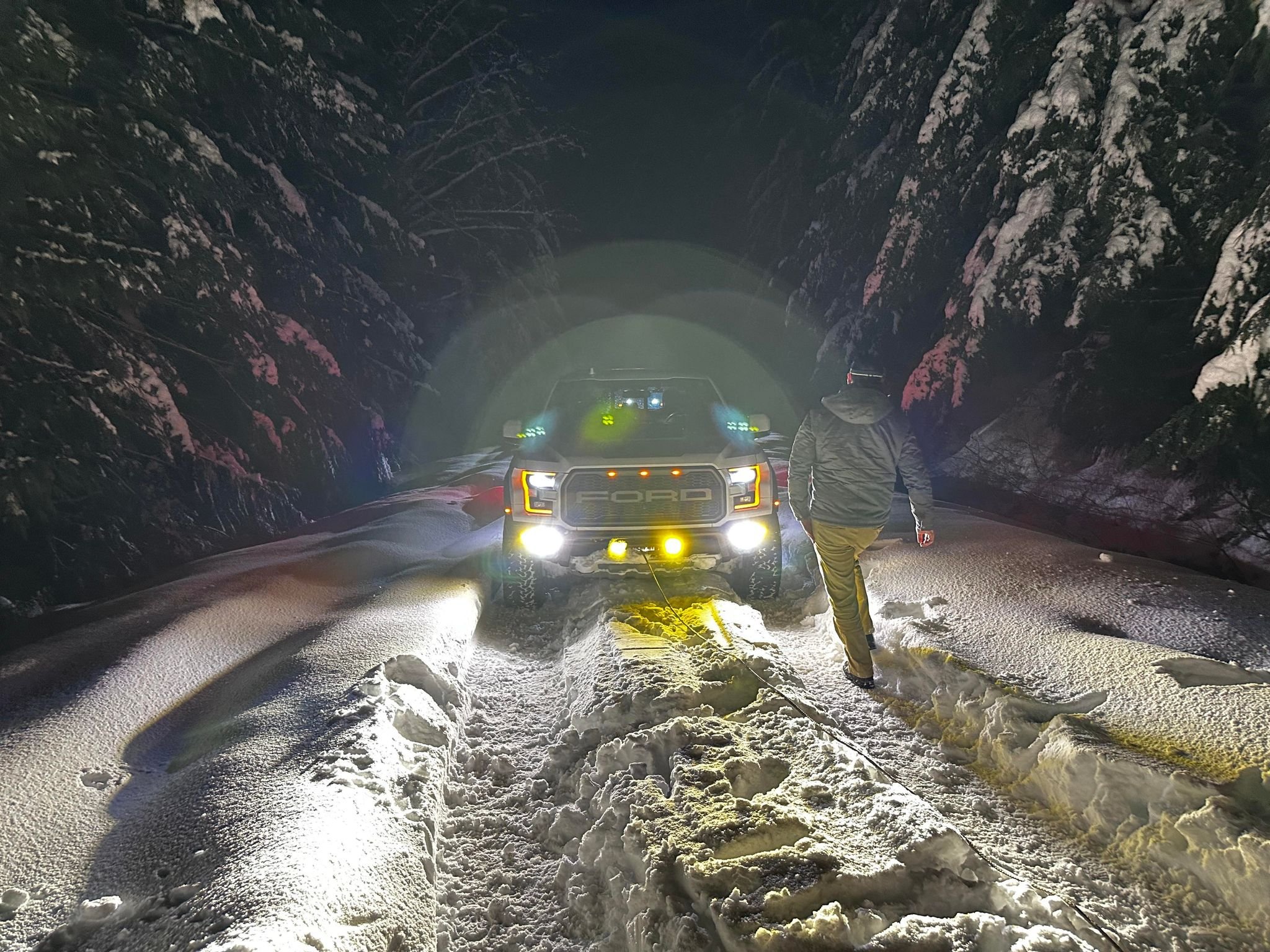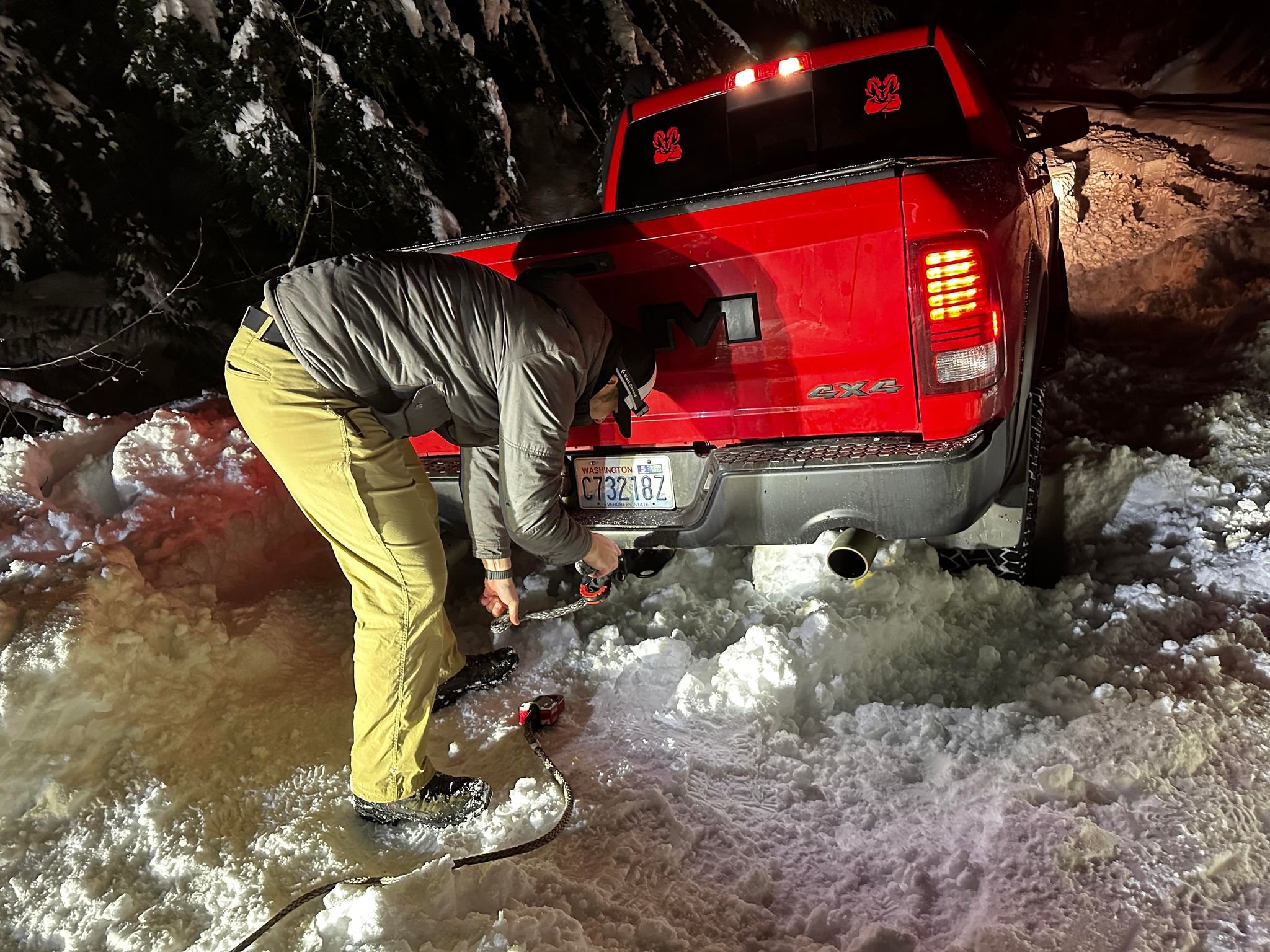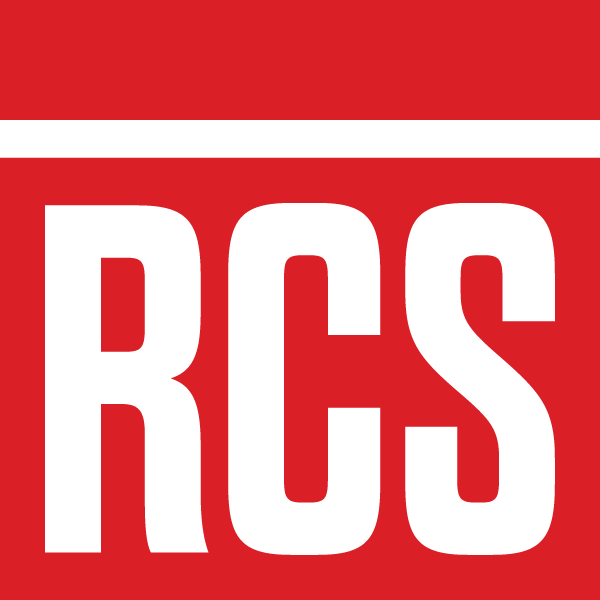The Off-Road Essentials
We get asked all the time, so we made a few highly controversial episodes (159 / 205) so you can disagree and yell at us while listening in your car!
Here is all the off-road gear we are carrying all the time and links for most of where you can get it. We do believe there may be better options out there depending on your vehicle and budget, but this is exactly what we have. You can basically one-stop-shop all of this at our friends at MULE Adventure Outfitters and HKP Customs where your Avants discount really helps! We are not “hardcore” off-road experts who hit up King of the Hammers or the Baja 1000, but we have been doing it a long time, and we do know this gear (and an occasional winch) get 99% of the work done and get you out of that snow bank or ditch.
The Basics for Off-Roading
Tires: BFG K02, Falken Wildpeak A/T3W, Goodyear Duratrac, etc. You can go down the rabbit hole of tire discussions forever, but anything is better than basic all season tires. We have found that most people are better off with an all terrain tire vs a mud terrain tire around here due to their superior on-road and ice performance.
The Duratrac is typically the local favorite, especially if you do a lot of snow-wheeling since they are studdable.
The Falken A/T3W is not cheap, but typically the cheapest of the 3 listed and a great performer in all PNW conditions with a great balance of tread life, traction, and cost.
The K02 is not our top choice for the PNW due to its wet weather performance, but it’s not a bad tire by any means. We think this is a great tire for just about every other area of the country or if you make a lot of trips to various terrains beyond the PNW, especially dryer climates where it is actually our preferred tire.
There are many other tires out there that may be a great choice for you, but these are our favorites and the favorites of our most experienced off-roading friends in Search and Rescue, 4x4 clubs, and more. Let us know if you’ve had great luck with other tires!
Air Compressor: For tires greater than 33” or if you just want a badass compressor, we love the ARB Twin compressor and still think it’s in a class (and price) of its own. For smaller, sub 33” tires, we recommend the ARB Single. It will still fill bigger tires, it just might need a rest and take longer. We also recommend the cheaper Smittybilt 2781 compressor for all size tires and for those on a budget. It does need a simple fitting change since it doesn’t come with a standard Type D - 1/4” connector like all other compressors, but for its low cost of entry it’s a great compressor that fills even the biggest tires and it just needs a cheap, simple mod. VIAIR also makes great compressors, but we didn’t feel for the money they were any better than the Smittybilt.
The ARB Twin is a 100% duty cycle air compressor, meaning you can use it constantly for as long as you need it. The ARB single, the Smittybilt, and almost every other compressor on the market are 50% duty cycle compressors, meaning they’re going to need a break to rest occasionally. This isn’t a bad thing, but it’s also a good reason to use a more efficient MorrFlate system, as mentioned below.
Tire Puncture Repair Kit: The ARB Speedy Seal II - We believe this is the most thorough kit available and made from quality parts. There are several knock-offs on Amazon, and they have good reviews, but we went with the original because it’s one we trust and it wasn’t too expensive at ~$50. If you’re on a budget, you do you and we won’t judge, but we do consider it essential off-road gear that we have used multiple times.
Sidewall Puncture Repair Kit: Gluetread! This stuff works and has been absolutely torture tested to prove it. If you ever get an “unrepairable” sidewall puncture, this is the stuff that will get you out of the trail and even home.
Deflator Kit: ARB E-Z Deflator. We had this marked as optional for a while, but considering it can save you almost 30 minutes vs the old way, we consider it a must have. Worth pointing out, we don’t believe you should buy the digital version. It works great, but we advise you to avoid batteries in anything as often as possible when an analog tool will do the job as it’s one less failure point.
Hitch Receiver Recovery Block: Agency 6 Aluminum is what Dan bought when MULE was out of stock, but MULE also makes their own and it’s every bit as good and made in the USA.
For an upgrade pick, we also recommend the 41.22 Skid Slider. You can see it in action here.
Kinetic Rope: Voodoo Offroad 30’ - Purchased at MULE, I go to this rope first for recovering another vehicle. Unlike a tow strap, this heavy duty bungee cord gently removes stuck vehicles without tearing their bumpers off and sending them flying with a good yank. If you’re looking for the best, we recommend Master Pull for all types of ropes and winch lines.
Soft Shackles: Dan has 2x Rhino USA Soft Shackles and 1 BubbaRope soft shackle. We don’t actually recommend the Rhino USA Soft Shackles or any Rhino USA products. This is not because they have failed or been a bad product, but because we believe their marketing is misleading as most of their products are not made in the USA as the name implies. We recommend Master Pull, Factor55 or VooDoo Off-road, available at MULE and made in the USA.
Hard Shackles: 3/4” D-Ring Shackles - We got some generic high strength shackles, but make sure you don’t by “cosmetic” shackles. Buy from a reputable brand, or literally anything MULE has in stock and you’ll be fine.
Tow Strap: TGL Generic Tow Strap - This is NOT in place of the kinetic strap, this is, as the name implies, for towing.
Recovery Tracks: ARB Tred Pro or the MaxTrax MK2, just be sure you know how to use them properly. We got ours at MULE.
We absolutely DO NOT recommend the TredPro mounting kit. It is one of the worst mounting kits we have ever used and is borderline unsafe. The MaxTrax Mounting Pins work for both brands. Dan’s are actually bolted to the rack itself for added security.
Navigation: Apps with offline guidance or a standalone, off-road GPS with SOS is essential for exploring. We highly recommend OnX Off-Road and Gaia. You get a 20% discount on an OnX premium membership via Avants! If you need a GPS for off-road and want a built in SOS, the Garmin Montana series is great.
The iPad Mini is a popular choice, but you need to opt for a model with cellular as the Wi-Fi only models do not have a built-in GPS receiver.
If you buy a standalone GPS, make sure it has an SOS option such as Garmin InReach, which will be clearly marked on the packaging.
The newer iPhone 14 models have an SOS feature built in, as does the watch. We haven’t tested it, but we have heard good things from online testers and apparently it works well.
Axe: Fiskars Chopping Axe - We recommend a chopping axe vs a splitting axe for the trail. Not only are they slightly lighter, but they are much better for chopping a tree that’s down thanks to their narrower blade profile. There’s nothing special about the Fiskars, but it’s cheap, light, and works.
Gerber has recently come out with the Bushcraft Axe, which includes a handy fire starter in the handle. We still think the Fiskars is a better Axe overall with its narrow head profile, but if you’re looking for a combo piece, it’s a good axe.
Shovel: DMOS Stealth Shovel - This surprisingly lived up to all the hype. It’s tough as nails, light, breaks down into a smaller footprint, and is great in snow. This is literally a lifetime shovel we love. That said, any shovel that doesn’t rust will do in a pinch, including the $30 aluminum special from Costco they have every year. Just don’t get a giant shovel that doesn’t fit in your truck and will rust.
Knife: I can’t count the number of times I use a pocket knife on a daily basis or when working on any car. The Kershaw Leek is what I personally carry due to its minimal size and tough build, but just have a good sharp knife of your preference. Once you get used to having one, you’ll never understand why you didn’t carry one
First Aid Kit: This basic kit on Amazon covers all the bases and it’s the one Dan has in the Raptor.
Tool Kit: Make a custom built tool kit for off-roading. While it’s tempting to grab a full, big kit to take along, chances are you’re seriously over-packing. Take a look at our tools page for some ideas, but this will be based on your vehicle and the common repairs that may be required. At a minimum, look around your vehicle for what size sockets and wrenches you would need to work on your suspension and remove your skid plates for access.
At the very least, this extremely minimal Husky kit from Home Depot has been a favorite and is good to have in any vehicle.
Be sure to also pack zip ties, some JB Weld or equivalent, and some pliers or vice-grips.
Pro Tip: It’s a good idea to designate a “tool guy” if you have a regular group you go with. I often carry a full set of tools, including small and large impacts, etc. It’s heavy, but there’s plenty of room in the Raptor.
Water and Food: We usually have a full case of water from Costco and a box of protein bars.
Warmth: A warm blanket or a packable sleeping bag. We recommend you look for that Eddie Bauer sale. You can get really high quality stuff you can just leave in your car for cheap and your passengers will be thankful when you go snow wheeling and get stuck.
Flashlight: We use a rechargeable LED flashlight and also carry a Black Diamond Spot 400 headlamp, which makes repairs under your vehicle much easier.
Fire Extinguisher: Do not overlook this essential piece of equipment! Any small fire extinguisher will do as long as it’s properly secured or we also recommend this fire extinguisher stick, which Dan has personally tested on a car on the side of the highway once.
Extra Clothes: Extra socks, gloves, and a rain jacket - Costco, Eddie Bauer sale, whatever, just have extras when you’re playing in the wet or snow.
Tarp: A basic Harbor Freight tarp is a lifesaver when you need to get under your vehicle in snow or mud and takes up virtually no interior space.
Beyond the Basics
Armor: Get sliders first! Even before the bumpers, we recommend sliders that attach to the frame for most people. The body damage caused by a rocker impact is often far more expensive and more common than what you’d get from a bumper impact. While it may sound expensive to spend $750-2,000 on sliders, even a minor repair to your rockers will be in excess of that. As you look at armor, we feel most people should start here (unless they are also mounting a winch).
Hitch Mounted Skid Plate: If you’ve got a vehicle with a longer overhang these are a cheap, effective way to save your exhaust tips and your bumper. We specifically recommend the DRT Fabrication Hitch Skid due to its extensive reinforcing and shape, which won’t get caught up on rocks.
Since the DRT Hitch Skid is constantly sold out, we also recommend the 41.22 Skid Slider, which may even work better if you do a lot of rock crawling. You can’t go wrong either way.
Suspension Upgrades: If you are doing a lift, don’t be cheap. IMS or remote reservoir shocks are always worth the $2-300 more. Any lift will give you better clearance and usually better than stock suspension performance, but it’s always worth it to spend just a little more for IMS or Remote Reservoir shocks when they’re available for your application. They absolutely do live up to the hype. Riding on them side by side, you’ll be so glad you spent the extra money for the IMS over standard Nitro Dual Monotubes.
This is a highly subjective topic based on your off-roading needs and there is no single answer. The point we want to make here is that the “entry level” lift isn’t usually the best choice for most people, regardless of how much off-roading you do. HKP and Mule can help you out and give you expert advice here, or shoot us a message!
Multi-Tire Inflation Kit: Morrflate 155” kit (though the 125” works for the Raptor) Morrflate now has a “Stubby” connector kit they call it which allows you to use a single line and makes it much easier to store. We still love the original kit, but this upgrade is worth the extra $30.
Lockers: We recommend an air-locker if you don’t have a factory locker. We personally advise air over electric due to the fact that they are faster to activate, typically engage exactly when you need them to, and you can use the compressor for airing back up your tires. Start with a rear locker if you’re getting a locker, even if you have a limited slip rear diff. Most people do not need a front locker until they get into crawling.
Do NOT skip on the installation. Get an expert to do this like MULE or Auburn Off-Road. We know it costs almost as much as the locker itself, and yes, it’s worth it. Don’t say we didn’t warn you if you “know a guy who can do it cheaper!”
Lights: We specifically recommend Baja Designs, VisionX, or Diode Dynamics. We know those cheap lights on Amazon sure are tempting, but if you are ever side by side with someone with any of our picks you’ll immediately understand the difference and the cost. We aren’t saying don’t get the cheaper ones if that’s all you can get - those are also worth it when you have no other lights, but the difference in output and beam pattern is substantial between the higher end lights and you won’t regret spending the money if you have the budget. We recommend working with HKP Customs for lights as well - many of us can vouch for their quality of work on custom installs.
Chase Lights: In high-dust conditions or fog these make a huge difference in a group. They are not a gimmick by any means and your group will be thankful you have them. Again, we highly recommend Baja Designs S2 Sports (NOT PROs) in the Driving/Combo or Wide Configuration or S1 in Wide Cornering for this application.
Phone and Electronics Mounting: Quad Lock Mounting system for phones, tablets, etc. We tried them all (seriously, it cost us a phone and hundreds in trial and error methods), but we firmly believe no one has done more research into mounting than Quad Lock. From wireless charging to anti-vibration to mounting compatibility (yes they work with RAM mounts), Quad Lock held our phones solid on the Backcountry Monkey Rally and our tablets steady even while doing high-speed off-roading in the Raptor. Even the generic stick-on mount is better than anything else we have come across and holds even the heaviest tablets.
Winch: Which Winch is which? After seeing a total failure and terrible customer service response from Smittybilt, we absolutely do not recommend getting a Smittybilt winch as their warranty was largely worthless and service borderline insulting. Warn, ComeUp, and Superwinch top our list for personal recommendations, with Warn’s Platinum series winches being by far our first choice since they are built in Oregon and we know they stand behind their products. ComeUp may not be as widely known, but MULE has torture tested theirs relentlessly and we trust them. Superwinch is our budget pick, as our friends that are using them have been very happy with their durability and speed.
Dan is running the Warn Zeon 12-S Platinum on his Raptor, and if you want the go-to winch, then you want that one or it’s 10-S little brother depending on your vehicle weight. For most non-competition vehicles, there simply is not a better winch on the market and every un-sponsored test has proven that.
The cheaper Warn EVO VR series is made in China. They work well and we haven’t seen any problems with them, but we don’t think they are any better than our Superwinch pick at a ~20% cost savings.
Snatch Block: If you have a winch, you also need a proper Snatch Block. We’re not snatch snobs, even the Warn snatch is made in China now. Don’t be fooled by Rhino USA or GearAmerica, as those are also made in China. The quality on both of those snatches is fine and we even think the GearAmerica snatch is a good product, but if you want a true, made in USA snatch then you want the Master Pull or AEV. Avoid older style snatches like this one from Smittybilt if you’re running synthetic line. The tolerance between the pulley and frame is too wide, and the line can get stuck and then cut if it slips off the pulley. Considering this is an item you typically only buy once and use forever, we DO recommend the Master Pull or AEV above all others, with Warn being the other choice.
The Donut! For synthetic line winches, this is a game changer that we believe in. Our friends at Factor 55 changed the game again with this rope retention pully, aka the donut, and it takes the place of your snatch block. The only downside is it’s not compatible with wire winches, so we recommend carrying it in addition to a regular one for sharing.
Tree Saver: TGL Generic Strap - SAVE THE TREES! It’s essential if you have a winch, but not required if you don’t, and it has never given us any problems over 10+ years of use.
Winch Line: With very rare exceptions, synthetic winch lines are better. It never rusts, doesn’t snap when it breaks, and is much easier to handle. If you ever need to replace your winch line, we recommend the Master Pull lines, in spite of the fact they cost almost as much as a winch itself. We dare you to compare, as these are in a class of their own and worth every penny.
Winch Mount: Do not skip on the mounting hardware for your winch. A good winch mount may cost anywhere from $200 and way up if you get a replacement bumper, but but we have seen bad mounts twist bumpers, frames, and even break during hard pulls. Winch mounting is every bit as important as the winch itself and you should only buy from a trusted source, not whatever is cheap on Amazon. An OEM mount is usually the most cost effective solution when available, but this is a great time to save up for a new winch bumper which will usually give you the added benefit of a better approach angle.
Radio: Baofeng BF-F8HP or Baofeng UV-5G - these are the “better than nothing” radios. To be clear, we don’t think these are good radios. They’re cheap, they work, and when they break we don’t feel too bad. Dan has 14 of them for rallies.
The UV-5G is a GMRS radio and some groups run GMRS vs UHF/VHF, so you may want to ask your friends what they have before you buy.
It is important to know the FCC laws around radios when using these, so we’ll leave that up to your discretion.
Battery Jump Starter: Gooloo GT4000S, if Project Farm says it’s the one to buy, it’s the one to buy. I’ve had mine for 2 years and started dozens of vehicles with it in all conditions and it’s worked every single time. I have since bought this one since I liked the screen and the very fast USB-C charging. This thing has jumped everything from completely dead diesel trucks to my Honda Monkey with ease, every single time. It also makes a great power bank (many do not) and can fast charge my iPhone 13 Pro Max.
Hand Saw: Silky Big Boy Hand Saw - There is no contest here; this is the best hand saw ever made for it’s size and nothing comes close to it. We checked. Before my chainsaws I used this to cut through trees most people would insist I need an axe or saw to remove. It’s sharp, fast, and folds down for easy storage so it’s always in the truck.
Chain Saw: The Stihl MS261 C-M or the DeWalt Flexvolt 18”. The DeWalt is a great saw, and I cleared 12 very dry, downed trees on the WABDR with it on a single 9AH battery, but.. it does lack the guts of the 2-Stroke saws when it comes to bigger trees. If you have a use case for a chainsaw beyond the trail, get the Stihl. If you’re a weekend warrior who sticks to the main overland routes, get the DeWalt. Note that the specific Stihl saw we mentioned has the ability to adapt to elevation and atmospheric changes, making it our go-to for off-roading and it starts pretty easily, even in very cold conditions. Dan carries the Stihl and Nick carries the DeWalt, but the DeWalt is the go-to first since it’s the easiest and quickest to use for small trees.
Note the DeWalt saw has a design flaw in the bar-oil filler. Before you even use it, get an O-ring from your hardware store which will stop it from leaking all over.
The Stihl MS261 C-M is an entry level PRO saw, and priced accordingly at around $700. We know that’s a lot, but we think it’s the best saw you can get for this specific application due to it’s size, weight, power, ease of starting, and overall fuel efficiency.
Storage for All This Gear:
Internal Storage: I have an under-seat storage system in the Raptor that fits all my gear except the chainsaw, compressor, and the traction boards, but I also have a bed storage system I built. We recommend buying vehicle specific options to maximize the available interior space and keep things secure when you’re bouncing around (or jumping things in Baja mode).
External Storage: If you are looking for a box for it all, Front Runner makes these handy boxes, but we actually think the best option is the DeWalt Tough System 2.0.
The earlier and temptingly cheaper DeWalt Tough System 1.0 boxes have metal latches that rust over time and can cut your hands, but the new ones are simply the best boxes we’ve ever used. No other boxes outside of the high-end Pelican cases even come close for toughness and these are 100% water tight.
A “nice to know” thing about the DeWalt Tough System boxes is that they fit between the built in 2x8 divider slots and the tailgate in Fords perfectly. This keeps them from sliding around and easy to access in the bed.
The Milwaukee boxes look nicer at first, but the aluminum bars tend to get damaged and gouged over time, leaving sharp metal burrs. The boxes also have less interior space and a larger overall external size.
Additional Resources for Beginners:
